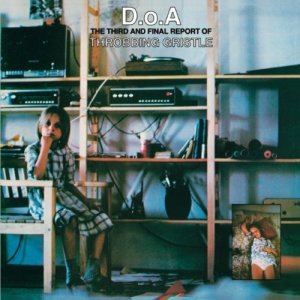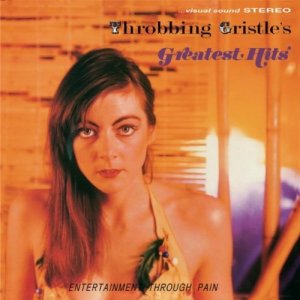Timing is everything. I first heard of Throbbing Gristle in the late ’80s, possibly as late as 1990, having read of them in books published by Re/Search. The only CD of their work I could find was a one-track item called CD1. I bought it and was bored. It was a humming, hissing, throbbing piece of electronic atmosphere, and I don’t think I made it all the way through even once. My interests moved in different directions in the years that followed; jazz aside, I was mostly listening to metal and punk, and the only industrial music I heard was of the Ministry/KMFDM/Nine Inch Nails school, plus Einstürzende Neubauten.
I kept seeing their name in print, and of course when they reunited a few years ago they were inescapable—Wire cover story, et cetera. They were enshrined as elder statesmen and cultural pioneers. And I still hadn’t heard them. So now here I am, as 2011 draws to a close, absorbing the Throbbing Gristle corpus for the first time. Their first five releases have been reissued, on their own Industrial label, as two-CD sets, paired with contemporaneous live recordings, non-LP singles, and whatnot.

Second Annual Report sets up the basic template: beds of analog synthesizer noise hum, waver, blat and zap in a way that’s like a slightly more ominous version of early ’70s Tangerine Dream. Over that, Genesis P-Orridge recites lyrics that are mostly disjointed attempts at provocation, frequently sexual in nature but also often delving into imagery of body trauma and violence, both one-to-one and state-sponsored.
Again, timing is everything. In late 1970s England, this sort of material was undoubtedly shocking. England’s a very conservative country now, culturally speaking, and back then it was surely even worse. But heard in 2011, in America, in a culture that’s basically awash in porn and aestheticized violence 24/7/365, it just seems kind of amateurish and teenaged (which it was)…and silly. I wind up wanting to pat P-Orridge on the head and say, “That’s nice, dear. Now let me show you something.” Sexuality in art is an arms race, and the English are never going to win against us Americans. That’s why over there, William Bennett of noise act Whitehouse could seem like a provocateur, while from here he seems like a pathetic try-hard. Musically, some of this stuff (“Forced Entry” from the live disc, for example) is quite cool-sounding; raw cranked-up electronics making noises that bear little or no relation to rock or any other type of conventional music. Throbbing Gristle are quite often successful at creating wordless but powerful atmospheres. It’s only when they make their ideas explicit, through lyrics, that they stumble.

The second album, D.O.A., goes farther in the direction of noise than its predecessor, and tapes of people talking are used much more often than recited lyrics. But there are also moments of great beauty, like “Weeping,” where the instrumentation is four overdubbed tracks of violin fed through an echo device. This album contains possibly the most famous Throbbing Gristle track, “Hamburger Lady,” the lyrics for which are a description of a burn victim taken from a letter sent to the group. Their engagement with the public was always a big part of their act; Second Annual Report included recordings of a flustered and somewhat pitiful-sounding P-Orridge hectoring an insufficiently respectful audience, while D.O.A. repurposes angry messages left on their answering machine. The bonus disc offers nine live tracks and the “Five Knuckle Shuffle”/”We Hate You (Little Girls)” single, and is easily the equal of the album itself, possibly better.

20 Jazz Funk Greats is the most conventional Throbbing Gristle album; the songs are mostly short, and almost all of them feature a drum machine, the endless ticking rhythm totally artificial-sounding, but imposing linearity on the music. The lyrics are still pointless and/or embarrassing, particularly on “Persuasion,” where P-Orridge attempts to play the role of a pornographer convincing a model to undress. I’ll say this much—he’s consistent, in that he sounds exactly the way he looks in the album art: a whiny nerd trying to stare down the camera. The best track on the album are the instrumental “Walkabout,” which could have soundtracked any ’80s Michael Mann movie, and “Six Six Sixties,” which features metallic guitar-like noises. “Hot On the Heels of Love,” a New Wave dance number that’s all but instrumental (it has two lines of lyrics, breathily whispered by the group’s sole female member, Cosey Fanni Tutti), is also pretty good. The bonus live material is pretty much the opposite of the album: noisy and assaultive, with lots of shouting from P-Orridge.

Heathen Earth is a live-in-the-studio performance. The group invited twenty people down to their studio, and recorded about 45 minutes of material, some of it improvised. It’s my favorite of all these albums, as it has a surging, oozing vitality that the studio material occasionally lacks. The pieces blend together into a seamless whole, and most of them are instrumental. When P-Orridge does open his mouth, it’s rarely for long, and his voice is usually filtered and echoey, making it difficult to hear what he’s groaning about. The bonus disc is a collection of live tracks from various places and times, totally different from the documentation-of-an-event feel of the album; you also get the “Subhuman”/”Adrenalin” single.

Greatest Hits is pretty much what its title suggests—a compilation of tracks from the first three albums and some singles. It comes in cover art intended to mimic 1950s exotica and is dedicated to Martin Denny, the towering figure in that genre. Oh, the irony—isn’t it just delicious? The bonus disc in this case is not live material, but more singles, studio outtakes and alternate mixes.
Part of me wishes I’d heard Throbbing Gristle when they were brand new. If I was as naïve when I first encountered their music as they were when they were making it, it might have had the world-shaking effect they were going for. But I’m a jaded old crank who’s heard all their descendents first, and seen a million things as bad as or worse than the burn victims and dead bodies they mutter about. So this stuff isn’t revolutionary—it’s retro. It’s the sound of a previous generation’s future. And while some of it’s pretty great (Heathen Earth in particular), a lot of it is simultaneously over-determined and under-cooked. And frankly, the live discs often leave the albums they’re paired with in the dust. Still, if you’ve never heard Throbbing Gristle either, these are clearly the editions to buy.
—Phil Freeman
Very entertaining review! I lived through the punk/post-punk era but also somehow missed hearing this group. Based on your article, I didn’t miss much. Read a relatively recent review with P-Orridge and he came across as a pretty sad figure. I think he was living in Brooklyn at the time.